This summer, I decided to make my very first fermented dill pickles and I quickly realized that that task was not nearly as easy as I thought it would be. I am sure many other newbies would have the same challenges. You may ask: how is that even possible? As they say, the devil is in those tiny details. It took me several batches and a whole bunch of research to come up with the recipe with which I was 100% happy.
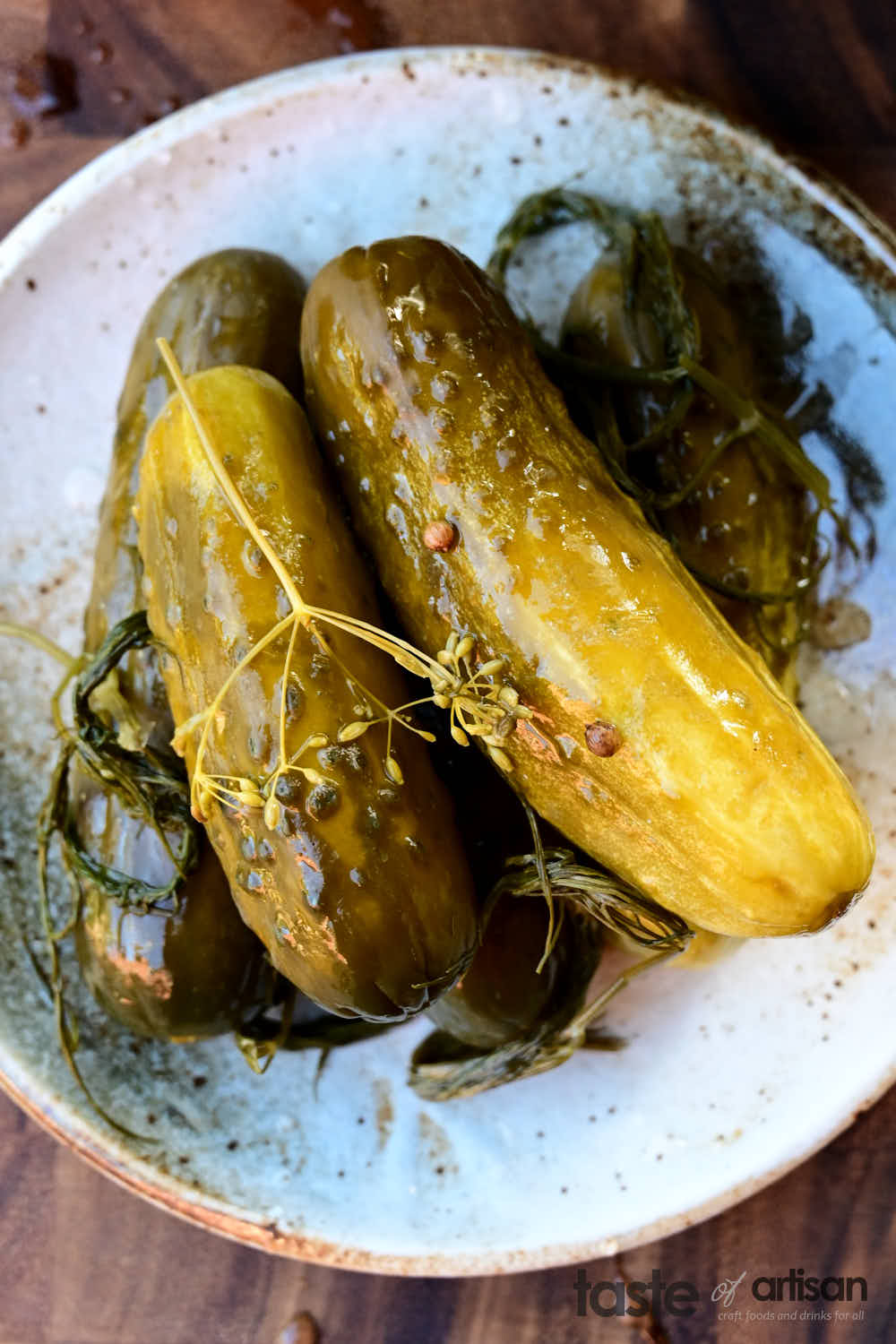
What are fermented pickles?
Fermented pickles are pickles prepared using the traditional process of natural fermentation in salt brine. The brine concentration can vary between 2% and more than 5%.
Vinegar is not needed in the brine of naturally fermented pickled cucumbers as the pickles become sour as a result of the activity of naturally occurring lactic acid bacteria. Pickles prepared with vinegar have a distinct vinegary taste that is inferior to fermented pickles. Ok, some may disagree with that statement but I would choose a fermented pickle over a vinegar pickle every time given the choice.
Fermented pickles are almost always fermented dill pickles. Why? Because pickles, or pickled cucumbers, are almost always seasoned with dill weed and dill seeds, which give them their distinct flavor. If you decide to skip dill, you will end up with fermented pickles.
Are fermented dill pickles the same as kosher dill pickles?
Dill pickles are also sometimes called kosher dill pickles. Can kosher dill pickles be fermented dill pickles? Yes. In fact, a typical kosher dill pickle is a fermented dill pickle, made in the traditional manner of Jewish New York City pickle makers. These pickles are typically made with a generous addition of garlic and dill to salt brine.
Full-sour vs half-sour fermented pickles
To make things more interesting, fermented kosher dill pickles can be full-sour and half-sour. Full-sour dill pickles are those that are fully fermented, while half-sour pickles are those that stay in brine only a short period of time, about 2-3 days. Half-sour pickles are still crisp and bright green. In Eastern Europe, these are also referred to as half-salty as the pickles that stay in brine for a shorter period of time will naturally be less salty.
My challenge making fermented dill pickles
My biggest challenge in making fermented pickles was how much salt to use. Search around for fermented pickle recipes and you will see how they differ from one another as far as how much salt to use. Some call for as low as 2-2.5% salt brine while others call for as high as 5%. Which ones are right? Is there the 'right' amount or is it a matter of personal preference? Which one is the safe amount? Which ones make a better-tasting pickle? My head was spinning while searching for the right answer. Making fermented sauerkraut wasn't nearly as challenging. The good news is that once you figure out the salt part, the rest is somewhat easy.
The 'right' amount of salt for fermented pickles
Salt plays a crucial part in the cucumber fermentation process. However, the more salt you add the saltier the pickles will be. Too salty a pickle is not a good thing. Less salty pickles are tastier. To a point. Pickles lacking in salt don't taste good either. There has to be a balance, the sweet spot. But where is it?
Similarly, the less salt you add the higher the likelihood of undesirable bacteria growing rapidly and spoiling your fermented pickles. To make matters even more challenging, the less salt you add the softer the resulting fermented pickles due to the enzymes which came from the cucumber itself, or yeasts and molds. So, more salt means more crunch.
Finally, what if you want to can your fermented pickles? Is there a minimum salt amount for fermented pickles to be safely canned?
After referencing numerous online and book resources, I found the answer in Stanley Marianski's Sauerkraut, Kimchi, Pickles & Relishes book. Marianski is the guru of anything smoked, cured, pickled and more, and is extremely health safety oriented. Here is the summary that he provides to this effect in his book:
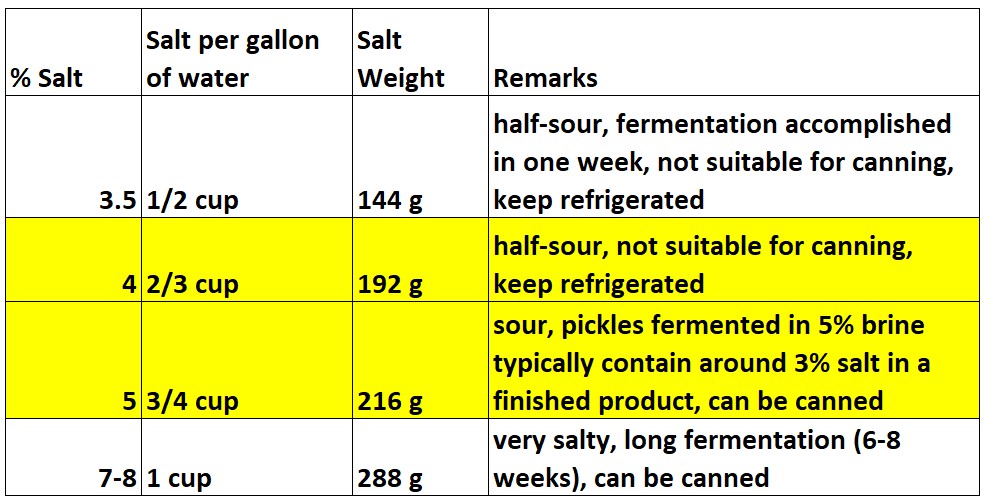
Does this make sense? Sort of. I am still a little unsure though. All I get from this is that the salt level must be at least 5% for canning fermented pickles safely but otherwise, the minimum safe salt level is 3.5% but he seems to recommend at least 4% (4% and 5% highlighted yellow in the book). Can I go any lower than that if I am willing to take the risk of my pickles possibly getting infected? Will they still taste good?
Experimenting with different salt levels
Seeing how some recipes for fermented pickles call for as little as 2.5% salt level, I decided to do some experimenting and see for myself. I fermented three jars of pickles with the only difference being the salt level. Spices and seasonings, fermentation temperature and fermentation time were identical. I picked at 2.5%, 3.5% and 4.5% salt levels. I could do 4% but I thought that 3.5% and 4% would be too close to judge effectively. Five percent seems too high to attempt when not planning on canning the pickles.
All three kinds were fermented for 8 days. The brine is a bit cloudy, did not use fermentation lids. More on that later.
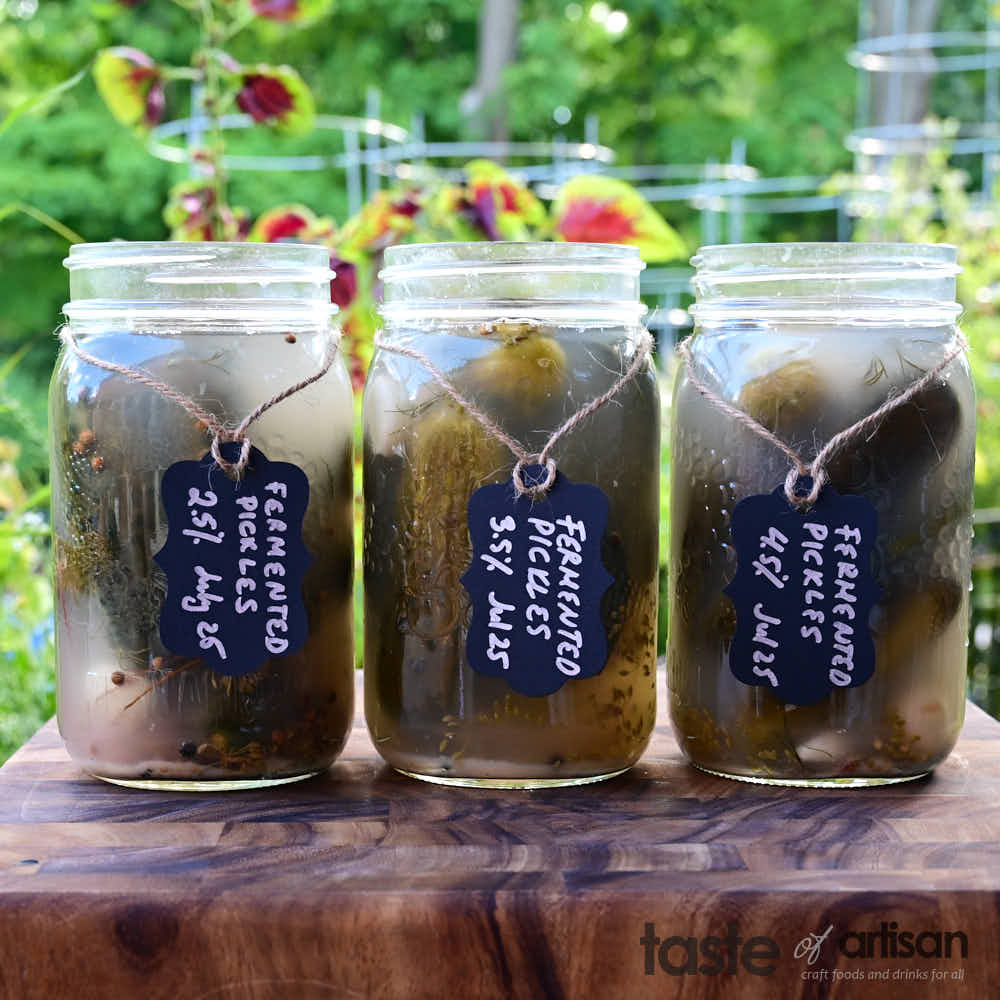
The results? They were a little surprising.
2.5% salt fermented pickles - Not salty enough! A little bland. Not enough flavor. Sourness slightly overpowering the flavor.
3.5% salt fermented pickles - Very good balance of flavor, sourness and saltiness. Noticeably more flavorful and generally tastier than the other two.
4.5% salt fermented pickles - A little too salty. The flavor got a little muddied by excessive salt.
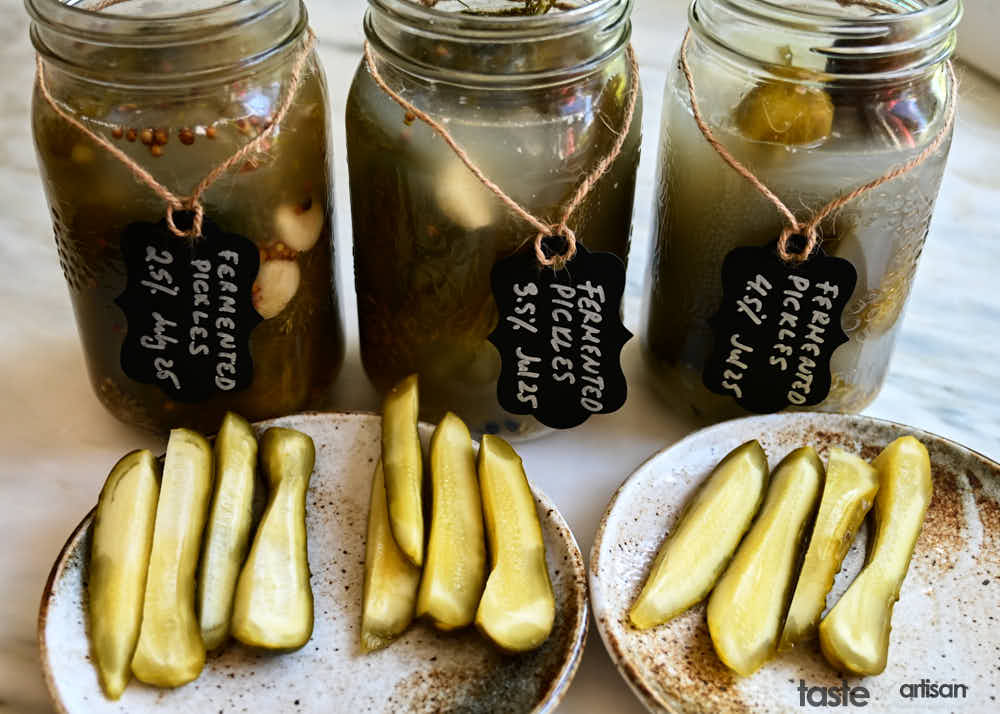
Honestly speaking though, if I tried each pickle on separate occasions, I would have probably liked each. But when comparing them side by side, you immediately see the clear winner.
So, my conclusion is to use 3.5% salt brine to make fermented pickles that will be refrigerated and 5% when making fermented pickles that will be brined.
Pickle fermentation process
With the salt levels out of the way, the rest is easy. Dissolve salt in room-temperature water, fill the jars with pickling cucumbers, add the spices and seasonings, pour water to cover the cucumbers and ferment for 8-10 days. Simple enough.
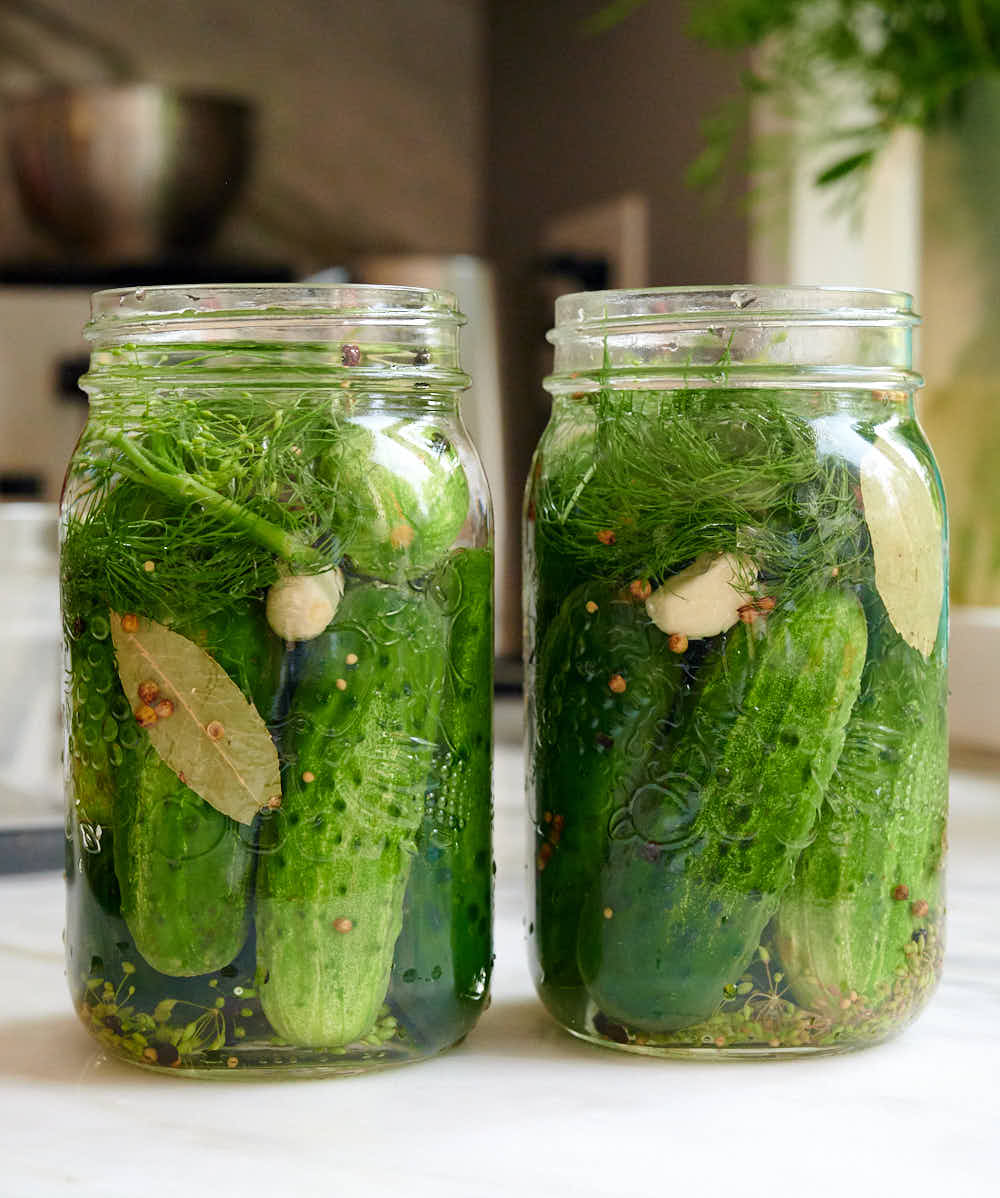
Fermentation Temperature
Cucumbers ferment best at 64F - 72F (18C - 22C) temperature. At this temperature, the optimal lactic acid bacteria strain will dominate during the fermentation process. At those temperatures, the fermentation process is accomplished in about 8-10 days.
A few tips
- Wash cucumbers of visible dirt but don't scrape them or brush them off. There are some lactic acid bacteria present on the surface
and they are needed to start fermentation. - Remove all remnants of cucumber blossoms as molds and tissue softening enzymes are known to reside in those areas.
- Add turmeric to improve the color of the final product.
- Add chopped or sliced horseradish root to help keep pickled cucumbers crisp. Alternatively, you may add oak or black currant leaves.
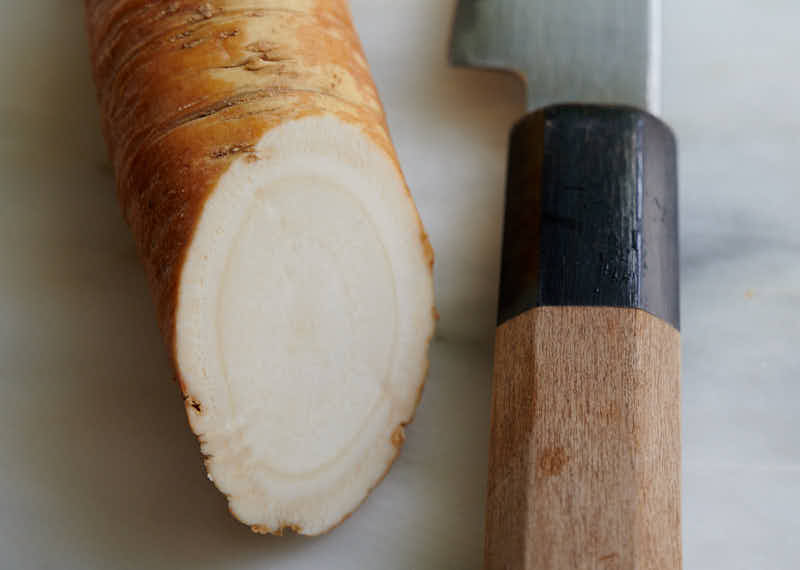
- Home-made fermented pickles develop soft texture due to the enzymatic activity. One solution is to soak cucumbers for 12-24 hours in a solution of 1 cup of food-grade lime to 1 gallon of water. Excess lime absorbed by the cucumbers is removed by draining cucumbers, rinsing and then re-soaking them in fresh water for 1 hour. This rinsing and soaking step should be performed a total of 3 times.
- Keep the cucumbers submerged in liquid during the entire fermentation process. I find that placing the top layer of pickles across the jar mouth will keep them down.
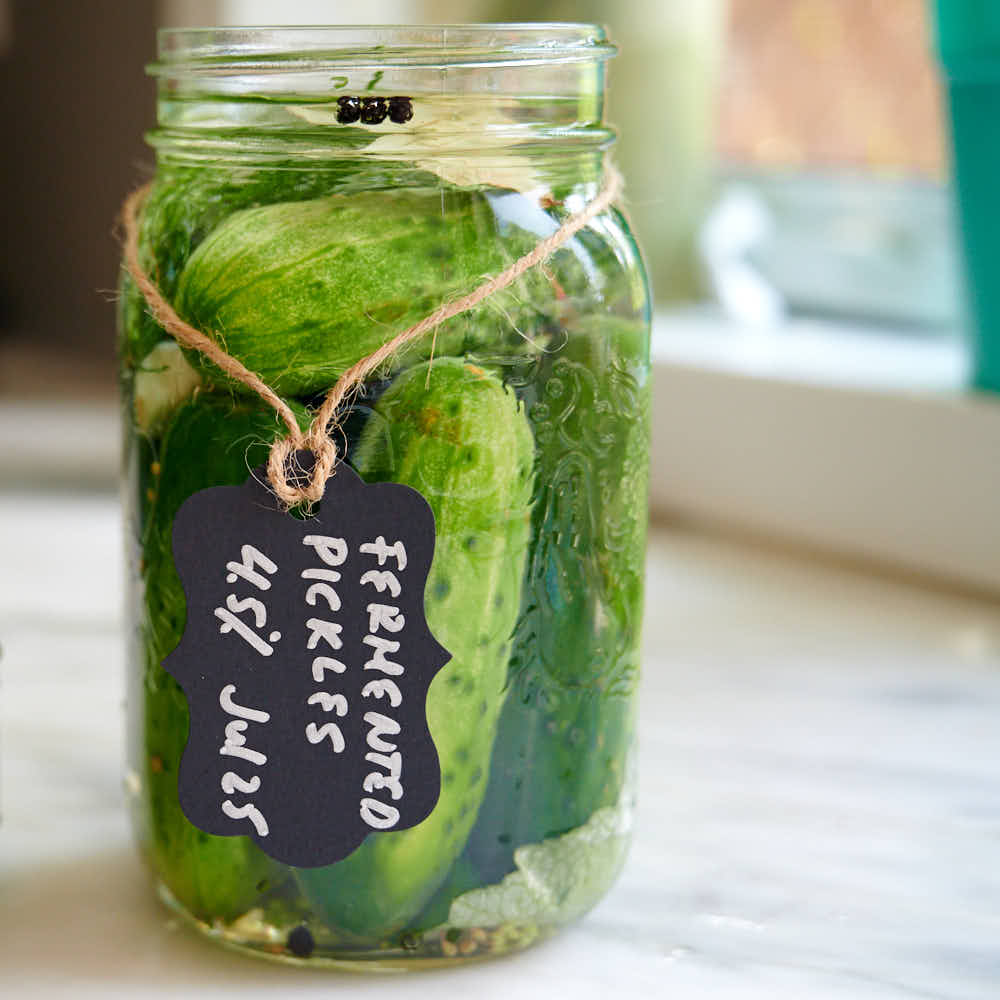
- The liquid in the jars will become cloudy as a result of lactic acid bacteria activity. This is normal. You will also see some white sediment collected at the bottom. This is also normal.
- Check the pickles daily. Any traces of slime should be discarded right away. Those are the enzymes that soften pickles. You don't want to keep them in the jar.
- You can place a small Ziploc bag filled with brine on top of the pickles. The bag will create an anaerobic environment that will restrict the production of slime by yeast.
- Better yet, get yourself some wide-mouth jars and fermentation lids fitted with airlocks. These lids will expel excess CO2 but keep oxygen out, preventing the formation of slime. The brine will end up being less cloudy too.
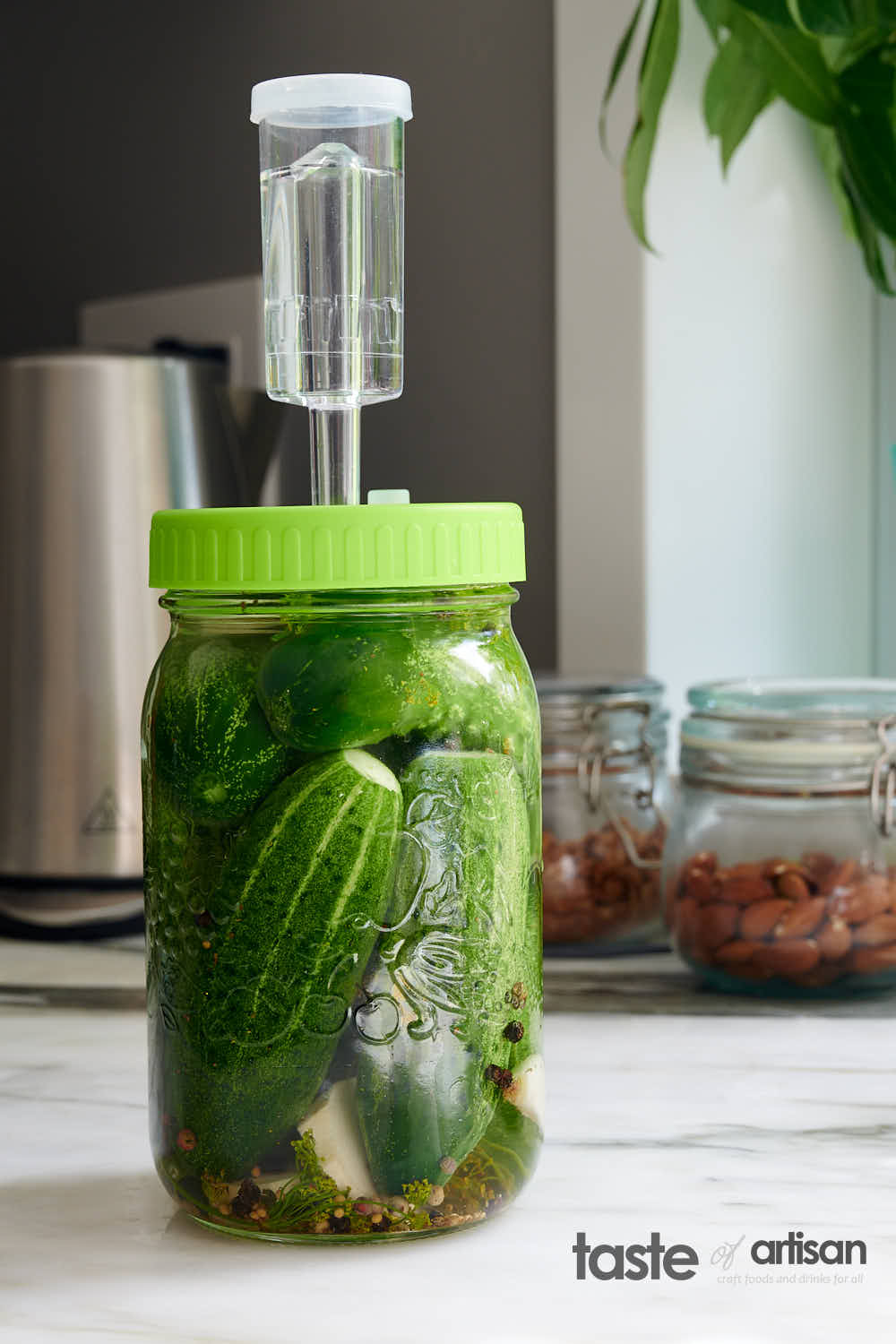
- When transferring pickles to the fridge, you can leave them as is. Alternatively, you may filter the liquid using a coffee filter to reduce cloudiness if it bothers you. Yet another option is to make a new brine and transfer the fermented pickles into a new jar with a new liquid for storage. This will, however, drastically reduce the flavor of the brine.
- If by the end of fermentation the pickles are soft, slippery or slimy, they may be spoiled so it's recommended to discard them.
- You can eat partly fermented pickles after 3-4 days. They will still be deep green color, but the color will start turning olive green over time.
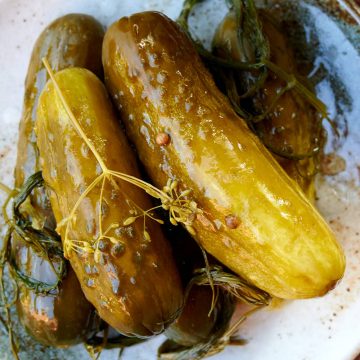
Fermented Dill Pickles
Ingredients
- 8 pickling cucumbers a mix of large and small
- 2 1/4 cups water about 532 ml; room temperature
- 1 Tbsp pickling salt about 18 g
- 2 cloves garlic
- 1 inch horseradish root peeled and sliced or diced
- 2 dill umbrellas or 3-5 dill twigs
- 12 peppercorns black or assorted pink, green, white and black
- 8 coriander seeds
- 2 bay leaves
- 10 mustard seeds
- 2 cloves whole
- 2 berries allspice whole
Instructions
- Wash cucumbers but don't brush them off. There are lactic acid bacteria on the surface that are needed to start fermentation.
- Cut off about 1/16 inch (1.5 mm) off the blossom ends of cucumbers. Molds and tissue softening enzymes are known to reside in the cucumber blossom area.
- Prepare 2 1/4 cups of 3.5% salt brine by whisking 1 Tbsp (18 grams) with water until the salt is dissolved.
- Place half of the seasonings at the bottom of a clean 1-quart jar. Add the cucumbers. Arrange the top cucumber across the jar to prevent them from floating. Add the rest of the seasonings on top.
- Pour in the brine leaving about 1/2" of headspace while making sure the cucumbers are covered with the liquid.
- Attach the fermentation lid with an airlock filled with the leftover brine. Make sure that the bottom tip of the airlock stays slightly above the liquid. (see note 1)
- Ferment at 64F - 72F (18C - 22C). You should see bubbles going up after about 16-24 hours when fermenting at around 68F. Longer if fermenting at lower temperatures and a bit sooner if fermenting at higher temperatures.
- Ferment for 3-4 days for half-sour pickles and 8-10 days for full-sour pickles.
- Taste the pickles. If you are happy with the results, place them in the fridge which will stop further fermentation. (see notes 2 and 3)
Special Equipment
- One 1-quart wide-mouth pickling jar
- One fermentation lid with an airlock
Notes
Nutrition


Rebecca says
Hi there! For pickles and other veggies like cauliflower, are you supposed to weigh the veggies along with the water and then multiply that total by .035 to make the brine? Or do you only weigh the water regardless of the amount of veggies you have? I’ve been researching trying to find this out but it seems people have very mixed opinions on this. Just wondering if both are safe and will still taste good. Thanks!
Victor @ Taste of Artisan says
Rebecca, for all of my pickled vegetables, I only weigh the water to calculate the salt portion for the brine. Otherwise your brine will be way too salty and your veggies inedible. The literature sources that I trust recommend this as well. Once the veggies are fermented (achieve the desired acidity level), keep them refrigerated. Good luck!
Gitty says
Tried these pickles and I’m not seeing any bubbles. It’s been 10 days. Can I taste them already?
Victor @ Taste of Artisan says
If you are not seeing any bubbles fermentation may not have started. Smell the brine. If you smell any off flavors it's not good. Also check for any mold formation, that's not good either. If the brine smells good, you can give it a taste, it should be acidic. Then taste the pickles. If they taste good and acidic enough, transfer to the fridge. If not, let them ferment longer. Hope this helps.
Carolyn says
Excited to try your recipe and thank you for "doing the work" for the rest of us! A few months ago, I tried a recipe from a (usually reliable) book on fermented veggies that was just too durn salty. Your goldilocks 3.5% solution sounds just right.
Victor @ Taste of Artisan says
I don't like salty food; this one, as far as fermented pickles go, is just for for my taste. I hope you like it. You could drop the salt level to 3% if you want. Not sure if you like the taste if you go lower. I didn't. Enjoy!
Larry Kelly says
I want to use 64 oz jars. Can I just multipley x4 with your recipe? Thanks
Victor @ Taste of Artisan says
Yes, that's exactly what you should do. Enjoy!
Norman Dale says
Thank you for the recipe. When you age the pickles for 8 to 10 days, what room temperature have you found best. I have made a similar recipe in the past but they didn't get full sour. I wondered if the room was too cool and if maybe I should but them in the oven with light on which creates surroundings at about 78F.
Victor @ Taste of Artisan says
Hi Norman, my room temps stay at around 70-72 in summer. If you the don't sour enough for your taste, just let them ferment longer. They can easily go on for 3 weeks, even four. I wouldn't increase fermentation temperature above 72F as that may impact the flavor. Good luck!
TomB says
The best use of the brine after eating the pickles is in dirty martinis. It has a gentle acidity (lactic) compared to that in olive jars. I have a couple friends that just want a jar of leftover brine for this purpose, don’t care about the pickles.
Victor @ Taste of Artisan says
LOL Good idea. It's also good for treating hangovers. I am not kidding. It works.
Steve says
Victor, Alcaraz was drinking pickle juice between games at the French Open to battle leg cramps. Maybe you can post on making pickle juice for athletes. 😉
We had an early spring here and temperatures have been very warm. My cucumbers are doing really well. Hoping for a bumper crop.
Victor @ Taste of Artisan says
Glad to hear it, Steve. I am hoping for a bumper crop too this year. I fight cucumber beetles every year and seem have finally found a great solution, so, fingers crossed.
You don't say, I had no idea that Carlitos did that, and I am a BIG tennis fan who watches a lot of matches throughout the year 🙂 You know, pickle juice is also good as a cure for hangover, and recently, I've seen many online articles about its health benefits as a probiotic and such... Glad to see the masses catching up to eating and drinking more of the old-fashioned, natural foods.
Steve says
TomB, I just tried this last week. It was awesome. I think next year I'm going to put down some gherkin sized dills and use them instead of olives in my martinis.
Tom says
Good idea. I’ve done 2:1 gin:brine and very good. 1:1 is a bit too savory for my taste
Steve says
Hi Victor, I tasted my first result making pickles this way. I made the canning pickles recipe last year and currently have a batch fermenting. I was surprised at the different taste, colour and texture of the 3.5% pickles. I think I prefer the canning pickles. They have a more sour flavour, a deeper colour and overall match my memories of grandma's pickles. Don't get me wrong, the result for the 3.5% pickles was very tasty. Just not what I expected.
Victor @ Taste of Artisan says
Steve, the 3.5% pickles are a different product. You can't can them as they don't have enough salt, they can only be stored refrigerated. There is another type of pickels that are low salt, and another one half-sour. My grandparents usd to make all kinds to satisfy differnet tastes/different purposes. Tastes differ as they say 😉 Enjoy!
Byron says
For a 5% solution the chart says 216 g of salt. For 3/4 of a cup of water. 216 g is almost a half a pound of salt it. 3/4 of a cup of water is about 180 grams.
Please correct me if I’m mistaken, but I think that chart is way off.
Victor @ Taste of Artisan says
No, that's 3/4 cup or 216g of salt per gallon of water. Look at the top of the column, it says per gallon of water.
Vaso says
Hello! May I ask how long do they last in the fridge? Thank you!
Victor @ Taste of Artisan says
Hi Vaso, 6+ months for sure. We finished our last jar just about a week ago, it was in the fridge since about July/early August and the pickles were outstanding - same taste, pretty good crunch, didn't get any saltier or sourer than they were originally just after fermentation. I would say that they could keep in the fridge much longer than 6 months. I did not notice much, if any, of taste/appearance deterioration. The taste was heavenly. Much, much better than store-bought pickles. They don't have that harsh vinegary taste, instead, they have a rounded tart taste and mild saltiness. I haven't tested how long they'd last before they go bad as they disappear so fast, I had to constantly remind everyone to save one jar for the holidays ;). Next year, I plan to make more of these and hopefully, they will last me all the way to the following summer.